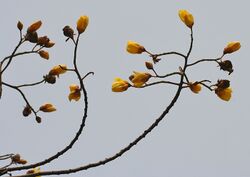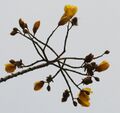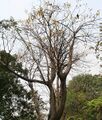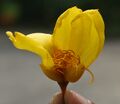Biology:Cochlospermum religiosum
| Cochlospermum religiosum | |
|---|---|

| |
| Cochlospermum religiosum blossoms | |
| Scientific classification | |
| Kingdom: | Plantae |
| Clade: | Tracheophytes |
| Clade: | Angiosperms |
| Clade: | Eudicots |
| Clade: | Rosids |
| Order: | Malvales |
| Family: | Bixaceae |
| Genus: | Cochlospermum |
| Species: | C. religiosum
|
| Binomial name | |
| Cochlospermum religiosum (L.) Alston
| |
| Synonyms[1] | |
|
List
| |
Cochlospermum religiosum is a flowering plant from the tropical region of Southeast Asia and the Indian Subcontinent. It is a small tree growing to a height of 7.5 m (25 ft) usually found in dry deciduous forests. The name religiosum derives from the fact that the flowers are used as temple offerings. It is also known as silk-cotton tree because the capsules containing the seeds have a fluffy cotton-like substance similar to kapok.[2] Another common name is buttercup tree because its yellow and bright flowers look like large-sized buttercups.[3]
In Theravada Buddhism, this plant is said to have used as the tree for achieved enlightenment, or Bodhi by nineteenth Buddha called "Siddhaththa - සිද්ධත්ථ". The plant is known as කිණිහිරියා (Kinihiriyaa) in Sinhala, and කණිකාර (Kanikaara) in Sanskrit..
Gallery
References
- ↑ "Cochlospermum religiosum (L.) Alston". Board of Trustees of the Royal Botanic Gardens, Kew. 2017. http://powo.science.kew.org/taxon/urn:lsid:ipni.org:names:169697-1#synonyms.
- ↑ USDA Cochlospermum religiosum (L.) Alston
- ↑ Flowers of India - Buttercup tree
External links
Wikidata ☰ Q58716 entry
 |









